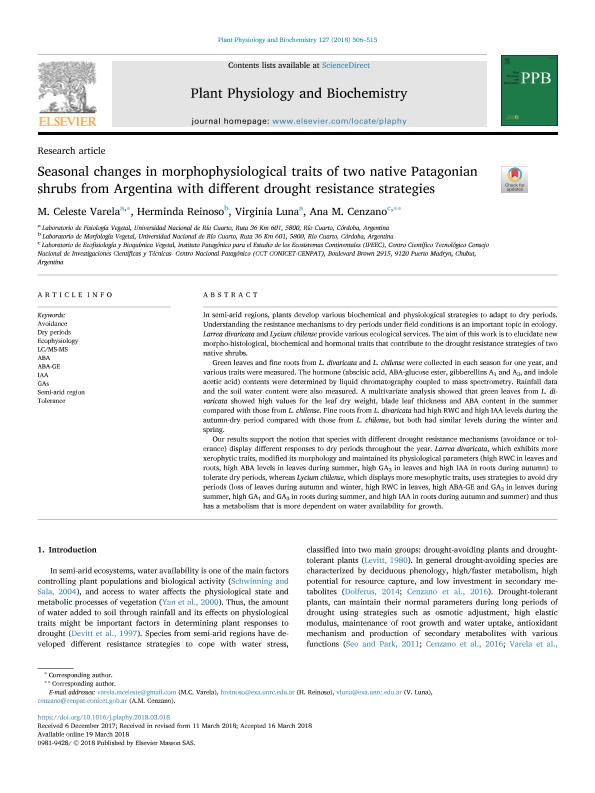Mostrar el registro sencillo del ítem
dc.contributor.author
Varela, María Celeste

dc.contributor.author
Reinoso, Herminda Elmira

dc.contributor.author
Luna, Maria Virginia

dc.contributor.author
Cenzano, Ana María

dc.date.available
2019-11-08T15:03:17Z
dc.date.issued
2018-06
dc.identifier.citation
Varela, María Celeste; Reinoso, Herminda Elmira; Luna, Maria Virginia; Cenzano, Ana María; Seasonal changes in morphophysiological traits of two native Patagonian shrubs from Argentina with different drought resistance strategies; Elsevier Masson; Plant Physiology and Biochemistry; 127; 6-2018; 506-515
dc.identifier.issn
0981-9428
dc.identifier.uri
http://hdl.handle.net/11336/88323
dc.description.abstract
In semi-arid regions, plants develop various biochemical and physiological strategies to adapt to dry periods. Understanding the resistance mechanisms to dry periods under field conditions is an important topic in ecology. Larrea divaricata and Lycium chilense provide various ecological services. The aim of this work is to elucidate new morpho-histological, biochemical and hormonal traits that contribute to the drought resistance strategies of two native shrubs. Green leaves and fine roots from L. divaricata and L. chilense were collected in each season for one year, and various traits were measured. The hormone (abscisic acid, ABA-glucose ester, gibberellins A1 and A3, and indole acetic acid) contents were determined by liquid chromatography coupled to mass spectrometry. Rainfall data and the soil water content were also measured. A multivariate analysis showed that green leaves from L. divaricata showed high values for the leaf dry weight, blade leaf thickness and ABA content in the summer compared with those from L. chilense. Fine roots from L. divaricata had high RWC and high IAA levels during the autumn-dry period compared with those from L. chilense, but both had similar levels during the winter and spring. Our results support the notion that species with different drought resistance mechanisms (avoidance or tolerance) display different responses to dry periods throughout the year. Larrea divaricata, which exhibits more xerophytic traits, modified its morphology and maintained its physiological parameters (high RWC in leaves and roots, high ABA levels in leaves during summer, high GA3 in leaves and high IAA in roots during autumn) to tolerate dry periods, whereas Lycium chilense, which displays more mesophytic traits, uses strategies to avoid dry periods (loss of leaves during autumn and winter, high RWC in leaves, high ABA-GE and GA3 in leaves during summer, high GA1 and GA3 in roots during summer, and high IAA in roots during autumn and summer) and thus has a metabolism that is more dependent on water availability for growth.
dc.format
application/pdf
dc.language.iso
eng
dc.publisher
Elsevier Masson

dc.rights
info:eu-repo/semantics/openAccess
dc.rights.uri
https://creativecommons.org/licenses/by-nc-nd/2.5/ar/
dc.subject
ABA
dc.subject
ABA-GE
dc.subject
AVOIDANCE
dc.subject
DRY PERIODS
dc.subject
ECOPHYSIOLOGY
dc.subject
GAS
dc.subject
IAA
dc.subject
LC/MS-MS
dc.subject
SEMI-ARID REGION
dc.subject
TOLERANCE
dc.subject.classification
Ciencias de las Plantas, Botánica

dc.subject.classification
Ciencias Biológicas

dc.subject.classification
CIENCIAS NATURALES Y EXACTAS

dc.title
Seasonal changes in morphophysiological traits of two native Patagonian shrubs from Argentina with different drought resistance strategies
dc.type
info:eu-repo/semantics/article
dc.type
info:ar-repo/semantics/artículo
dc.type
info:eu-repo/semantics/publishedVersion
dc.date.updated
2019-10-22T15:47:47Z
dc.journal.volume
127
dc.journal.pagination
506-515
dc.journal.pais
Francia

dc.journal.ciudad
Paris
dc.description.fil
Fil: Varela, María Celeste. Universidad Nacional de Río Cuarto. Facultad de Ciencias Exactas Fisicoquímicas y Naturales. Departamento de Biología Molecular. Laboratorio de Fisiología Vegetal; Argentina. Consejo Nacional de Investigaciones Científicas y Técnicas; Argentina
dc.description.fil
Fil: Reinoso, Herminda Elmira. Universidad Nacional de Río Cuarto; Argentina
dc.description.fil
Fil: Luna, Maria Virginia. Universidad Nacional de Río Cuarto. Facultad de Ciencias Exactas Fisicoquímicas y Naturales. Departamento de Biología Molecular. Laboratorio de Fisiología Vegetal; Argentina. Consejo Nacional de Investigaciones Científicas y Técnicas; Argentina
dc.description.fil
Fil: Cenzano, Ana María. Consejo Nacional de Investigaciones Científicas y Técnicas. Centro Científico Tecnológico Conicet - Centro Nacional Patagónico. Instituto Patagónico para el Estudio de los Ecosistemas Continentales; Argentina
dc.journal.title
Plant Physiology and Biochemistry

dc.relation.alternativeid
info:eu-repo/semantics/altIdentifier/doi/https://doi.org/10.1016/j.plaphy.2018.03.018
dc.relation.alternativeid
info:eu-repo/semantics/altIdentifier/url/https://www.sciencedirect.com/science/article/pii/S0981942818301414
Archivos asociados
